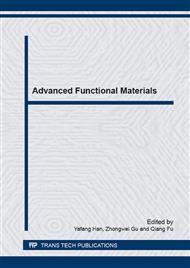p.396
p.401
p.407
p.412
p.424
p.429
p.434
p.440
p.446
Corneal Matrix Repair Carrier with Composite Silk Protein Membrane
Abstract:
Corneal transplantation is the only effective way to repair the damaged corneal tissue and solve the problem of insufficient donor cornea and immune rejection. Biocompatibility and stable transparent are necessary conditions of corneal stromal cells carrier. In this paper, the acetamide/silk (AC/SF) composite membranes are studied to be applied in corneal repair material. AC/SF membranes with different blending proportions had stable transparency, good cell compatibility. X-ray diffraction was used to investigate the structure of the composite films. The acetamide inhibited the formation of large crystalline particles, changed the crystal structure of silk fibroin and made the random coil structure convert to Silk I or Silk II. Therefore, acetamide was not only crosslinking agent but also crystallization inhibitor. The corneal stromal cells were seeded on sterilized composite membranes. After 5 h, the adhesion rate of stromal cells was more than 90%, cell could proliferate regularly on the composite membrane. There was no obvious difference in contrast to control plate. These results demonstrated that the composite membrane could promote corneal stromal cell proliferation.
Info:
Periodical:
Pages:
424-428
Citation:
Online since:
March 2015
Authors:
Keywords:
Price:
Сopyright:
© 2015 Trans Tech Publications Ltd. All Rights Reserved
Share:
Citation:


